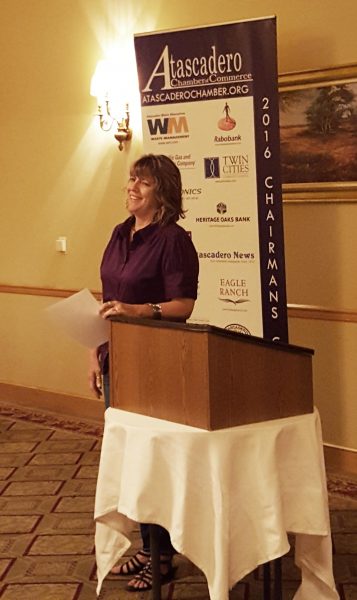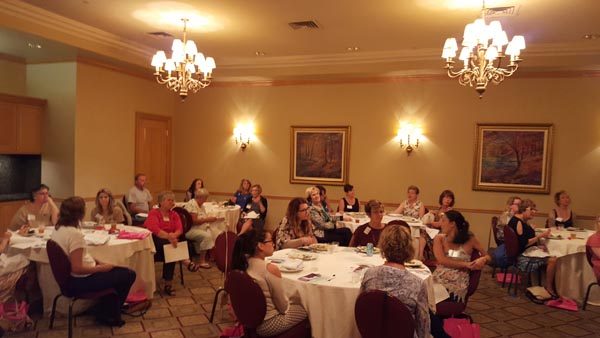Local business owner addresses dangers of GMOs

In 2015, the World Health Organization’s International Agency for Research on Cancer classified glyphosate, an active ingredient in Roundup, as a probable carcinogen for humans. Glyphosate has been linked to the increase of many cancers, such as breast, thyroid, kidney, pancreas, liver, bladder, and myeloid leukemia.
GMO plants linked to cancer, autoimmune disease, other ailments, Kubin says
–Leslie Kubin, owner of local business Healing the Quantum Way, gave a presentation on genetically modified foods and how they impact health at the most recent Atascadero Chamber of Commerce Women in Business luncheon held last Friday.

It is widely believed that chemicals in pesticides and herbicides found in plants can be rinsed off of the fruits and vegetables, however in the case of Roundup, for instance, Kubin (pictured here) says that there are specific chemicals that drive the product into the cells of the plant. “Roundup is still in there, it can’t be washed out.”
Kubin worked in toxicology for almost 20 years, which sparked an interest in her about the topic of GMOs and also possibly contributed to her illness due to exposure to chemicals, she says. Kubin has Multiple Sclerosis, and is able to manage it with nutrition and natural therapies such as supplements and bio-feedback therapy, things that she offers to clients in her practice in Atascadero.
A genetically modified organism is the result of a laboratory process where genes from the DNA of one species are extracted and artificially forced into the genes of an unrelated plant or animal. The foreign genes may come from bacteria, viruses, insects, animals or even humans. “Genetic engineering transfers genes across natural species barriers. It uses imprecise laboratory techniques that bear no resemblance to natural breeding, and is based on outdated concepts of how genes and cells work. Gene insertion is done either by shooting genes from a ‘gene gun’ into a plate of cells or by using bacteria to invade the cell with foreign DNA. The altered cell is then cloned into a plant,” from, The Mutational Consequences of Plant Transformation, Journal of Biomedicine and Biotechnology 2006.
A self-described research-addict, Kubin has been studying GMOs and their impact on her and others’ health for many years. Her personal pet peeve, she says, is Glyphosate, the active chemical found in the world’s most widely used pesticide Roundup.
The most commonly genetically modified foods are wheat, corn and soy. These crops are widely modified to make them, “Roundup ready,” meaning that farmers are able to saturate the plants in the pesticide at extremely high levels without the plant dying.
Kubin provided print outs with documented studies on the topic of Glyphosate. In an article published by The Alliance for Natural Health USA entitled, “Glyphosate Levels in Breakfast Foods: What is Safe?” The author states that, “Glyphosate was for many years touted by its makers as being harmless to humans and wildlife and rapidly biodegradable. In fact, because it was considered safe it was not monitored in the US by either the USDA’s Pesticide Data Program or the FDA’s Pesticide Residue Monitoring Program. However one year ago, March 20, 2015, the WHO’s International Agency for Research on Cancer (IARC) classified glyphosate as a probable carcinogen for humans. Glyphosate has been linked to the increase of many cancers, such as breast, thyroid, kidney, pancreas, liver, bladder, and myeloid leukemia.”
It is widely believed that chemicals in pesticides and herbicides found in plants can be rinsed off of the fruits and vegetables, however in the case of Roundup, for instance, Kubin says that there are specific chemicals that drive the product into the cells of the plant. “Roundup is still in there, it can’t be washed out.”
Another particularly dangerous type of genetic modification is a technique designed to make plants more resistant to viruses. The plant is designed to not recognize the virus and therefore not fight it off as it usually would. That modification, when consumed, gets inserted into human cells as well, leaving us defenseless against disease, according to Kubin. These and other modifications attribute to the upswing in auto-immune disease, such as MS, Celiac, Chron’s Disease and others, she says.
When genetic modification was first introduced, it was widely touted as a solution to world hunger. Companies claimed that GMO fields produced more crops. This assertion has been proven false, Kubin says. GMO crops, when averaged over many harvests, produce no more than traditionally grown crops.
Genetically modified foods have also led to the evolution of, “Super bugs” that are resistant to pesticides and herbicides. The lack of genetic diversity can also create mass losses in yield, as one bug will effect the entire genetically identical crop.

Attendees seemed responsive to the information, and were ready to look at ways to reduce their exposure to GMOs.
Addressing ways to decrease exposure to GMO, Kubin is an advocate of buying organic, gardening and supporting small non-GMO local farms such as Talley Farms in Arroyo Grande. She warns that the label “Organic” doesn’t always mean that a plant is non-GMO. Chemicals such as those found in Roundup can stay in the soil for generations and show up in organic crops that have never been sprayed. These same contaminates drain into waterways after rain and watering, poisoning fish and other wildlife, and make their way into public water systems as well.
Kubin recognizes that in today’s world, it is virtually impossible to avoid consuming GMO or chemically-laden food and water. Ultimately, Kubin urges the public to educate themselves about what they are putting into their bodies on a daily basis, and to take steps to limit exposure as much as possible.











